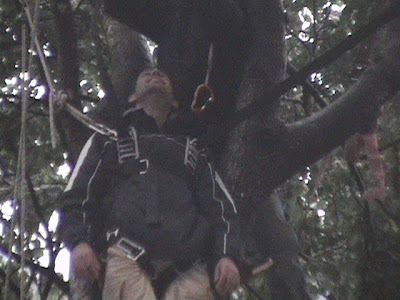To Donate to Homes For Our Troops:
http://www.homesforourtroops.org/goto/Expedition3000
After we arrived we checked in with the BASE club and the camping area to get our cabin. . We registered with the club after they verified our experience and gave us a brief on the area. We picked up different packing tips for a terminal jump, got instruction on the area, club policies, exit points, landing areas, and rescue operations.


We took a boat ride and got dropped off at the landing area to have a look around. Inspecting the landing area was mandatory and extremely important before anyone could jump. The landing area had huge boulders and the area was unforgiving. There were several locations to land and it was important that you made these areas because the terrain was dangerous. The other option would be to fly straight and land in the water and be picked up by the boat. Their is a saying in base jumping that states, "You Dry Faster Than You Heal". Although landing in the water can be dangerous as well. The parachute saturates and gets very heavy and it is very easy to get tangled in your lines and have the canopy come down over your head. Before jumpers exit, they are in radio contact with the boat operator who watches for any malfunctions or water landings, so he can expedite pick up or rescue operations. Every jumper gives either a ten or thirty second call, telling the boat operator what exit point they are jumping from and how many jumpers will exit at the same time on that particular jump.
 Although it was not required the team decided to get trained on a rope system called the Pendulator which simulates body position when exiting the cliff. Body position is critical and it allows a jumper to exit stable and then streamline their body position to get away from the wall. With poor body position a jumper could go unstable and impact outcroppings of the cliff below them, which would most likely result in serious injury or death. A jumper could also minimize the distance they fly away from the wall which increases the possibility of a wall strike if the jumper has an off heading opening or has to deploy their parachute for any reason.
Although it was not required the team decided to get trained on a rope system called the Pendulator which simulates body position when exiting the cliff. Body position is critical and it allows a jumper to exit stable and then streamline their body position to get away from the wall. With poor body position a jumper could go unstable and impact outcroppings of the cliff below them, which would most likely result in serious injury or death. A jumper could also minimize the distance they fly away from the wall which increases the possibility of a wall strike if the jumper has an off heading opening or has to deploy their parachute for any reason. 
 The next day we got up and caught the van ride up the cliff road to the drop off point. We then started the strenuous 3 mile hike which is practically straight up three hills. Once at the top the terrain is relatively flat. There a few stream crossings and fresh water is easy to find. We crossed two small glaciers and a few ravines hiking across the top. When the weather was clear the hike was enjoyable once at the top, but when it was bad the clouds rolled in which limited your visibility. You did not want to stray to far from the trail as you could walk off a 3000 foot cliff. After all, the object is to get the parachute on your back before that is done.
The next day we got up and caught the van ride up the cliff road to the drop off point. We then started the strenuous 3 mile hike which is practically straight up three hills. Once at the top the terrain is relatively flat. There a few stream crossings and fresh water is easy to find. We crossed two small glaciers and a few ravines hiking across the top. When the weather was clear the hike was enjoyable once at the top, but when it was bad the clouds rolled in which limited your visibility. You did not want to stray to far from the trail as you could walk off a 3000 foot cliff. After all, the object is to get the parachute on your back before that is done.Then we arrived at the exit point of Kjerag, the cliff that we would be jumping from. It was time to gear up and jump. The moment we had been waiting for was finally here! Now, All we had to do was take one more step!


























 After arriving in Stavanger we got the news that our baggage did not make it. So we waited for the next flight to come in from Denmark. After checking the arriving baggage we only received two of the six bags we were missing. So we waited. And then waited some more.
After arriving in Stavanger we got the news that our baggage did not make it. So we waited for the next flight to come in from Denmark. After checking the arriving baggage we only received two of the six bags we were missing. So we waited. And then waited some more.































































